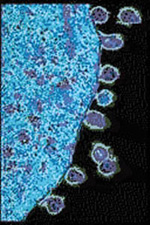Transmissible treatment proposed for HIV could target superspreaders to curb epidemic
By By Susan Brown | 18 Mar 2011
Biochemist Leor Weinberger and colleagues at the University of California, San Diego and UCLA have proposed a fundamentally new intervention for the HIV/AIDS epidemic based on engineered, virus-like particles that could subdue HIV infection within individual patients and spread to high-risk populations that are difficult for public health workers to reach.
 With a model that considers the effects of the proposed treatment on several scales, from interference with HIV in infected cells to viral loads in individual patients to the prevalence of HIV in large populations, they determined that the engineered particles could work in concert with current treatments for HIV infection and lower the prevalence of infection more effectively than current drugs or proposed vaccines alone. Their findings will appear in the March 17 issue of PLoS Computational Biology.
With a model that considers the effects of the proposed treatment on several scales, from interference with HIV in infected cells to viral loads in individual patients to the prevalence of HIV in large populations, they determined that the engineered particles could work in concert with current treatments for HIV infection and lower the prevalence of infection more effectively than current drugs or proposed vaccines alone. Their findings will appear in the March 17 issue of PLoS Computational Biology.
"Dr. Weinberger's idea to use engineered virus-derived particles to combat infectious diseases is truly provocative,'' said James Anderson, M.D., Ph.D., Director of the Division of Program Coordination, Planning, and Strategic Initiatives. Anderson oversees the NIH Common Fund, which supports a series of exceptionally high impact, trans-NIH programs including the NIH Director's New Innovator Award, which Weinberger received in 2009.
piggyback parasite
The engineered particles, called therapeutic interfering particles or TIPs, would persist for years in an individual patient and could be packed with genes that disrupt the functioning of HIV. Weinberger's team has succeeded in creating functional prototypes in the lab.
''TIPs are molecular parasites that 'piggyback' on HIV to spread between individuals,'' Weinberger said. The engineered particles use the same outer envelope as HIV but lack the genes for components of this structure and the enzymes needed to assemble it. They can only replicate, infect additional cells and transmit to new individuals by stealing these elements from HIV. Until the host cell is infected with HIV, TIPs remain dormant.






























